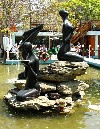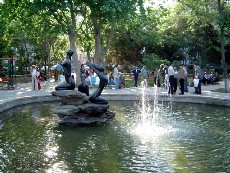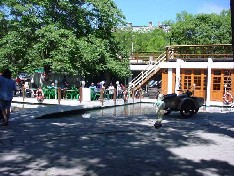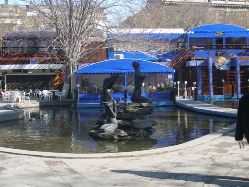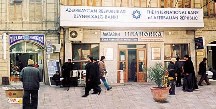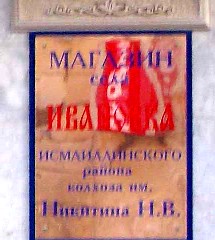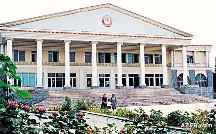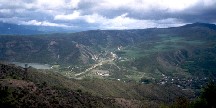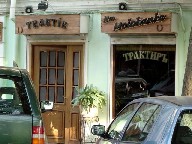Malakan / Molokan GardenBaku, AzerbaidjanCLICK on Pictures to ENLARGE
Updated:
17 May 2024
|
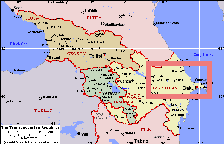 Transcaucasus. Azerbaidjan is yellow. |
|||||||||||
Anyone who searches on the
Internet for the words Molokan and Malakan will find that
in the country of Azerbaijan, in the capital city of Baku,
businesses and news often give directions by referring to
a landmark place variously spelled ...
Across the street are the Malacannes restaurant and the Molokan Inn Hotel. As of March 2024, the 4 streets around the park are pedestrian only � no loud cruisers allowed. What is this special place? Is it a garden or a park? Does it have anything to do with Spiritual Christian Molokane? There was even a Molokan Street in Baku that ran along the north side of this garden-park. See a postcard image of Молоканская ул. (Molokan street). 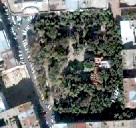 Yes!
It's a landmark garden-park on the east side old Baku with
an art sculpture fountain and cafe, about 2 blocks from
the Caspian Sea, covering a 2 acre city block. Yes!
It's a landmark garden-park on the east side old Baku with
an art sculpture fountain and cafe, about 2 blocks from
the Caspian Sea, covering a 2 acre city block. See a 360-degree panoramic photo made in the middle of the park. Find it on this Gateways Hotel map marked in English: "Malokan Park". This aerial photo (left) shows that it's in a fashionable and desirable area near international businesses, embassies, restaurants, theaters, the main library, colleges, metro (subway), and shopping. I first posted about this place on Molokan NEWS 2001 but did not know what or where it was:
Since Faig's help and photos (right), at least 8 more art photos of the Molokan Garden have been posted by people living in Baku who like this park. Click on pictures to ENLARGE. In 2006 Google posted aerial photos of Baku.
See 19 more historic photos labeled in Russian at "Baku Pages": Галерея: Парки и сады: Мариинский (Молоканский) сад - сад 9-го января - сад им. Хагани The Molokan Garden (malakanka) is one of the landmarks and tourist attractions in old downtown Baku, nick-named after the Molokane who originally lived there. It's 2 blocks from Baku Harbor, about 2 blocks from the Sahil metro station, and bound by Khagani Street (north), Uzeyir Hajibeyov Street (south), Gogol (east), and Rasul Rza Street (west). Click on the maps to enlarge them. Faig reports that since about 1843 [actually about 1839], the Russian Tsar's government started to move Molokane to the Caucasus. Many were settled in the rural areas of Azerbaijan and brought their harvest to Baku to sell. In 1850-60s, on the place of the current garden park, Molokane created a market with many shed booths (to protect their products), and camped or lived in motels around it. For simplicity, people in the Caucasus called all Spiritual Christians arriving from Russia malakan, so this term can broadly refer to any white immigrant from Russia, or specifically to the Molokan faith, hence the many spellings. This city district was unofficially named "Molokan square /garden" or "molokanka" (place of Molokans, malakane). Azeris typically say "malakanka" and often spell it that way. [Note that "molokanka" also means a female Molokan.] This market site, with horses and people camping, was too dirty for downtown, so city authorities decided to move the market out of the center and create a garden park instead. This was part of a beatification project to transform Baku into a modern (1800s) city with many parks within easy walking distance. This park went through 3 name changes.
In 2006 a new Baku website in 3 languages provides some history: Сад им. Хагани / Garden named Khagani. On 22 March 2006, Dr. Flynn, University of Washington, reported the corrupt Baku police demanding money from her at 1 am in the Molokan Gardens. See: Diary: Police State (offline 2024). The Molokan outdoor farmer's market � "bazar" � was replaced with a smalll store, "Magazin Ivanovka" (Ivanovka Market), one block north of the park on Nizami street. The marked is owned by the largest Molokan collective farm in Azerbaidjan, in Ivanovka village. Ivanovka Market is next to the International Bank of the Azerbaidjan Republilc. Besides the thousands of Molokans and Jumpers that live(d) in Baku and attended several large assemblies, most Azerbaidjan Molokans, Jumpers and Sabatarrians live in about a dozen villages 1-3 hours west of Baku, while others live in the south and east. The largest farm is named "N.V. Nikitin kolkhoz" in Ivanovka village, Izmailli [Ismayilli] region, which is 3 hours, ~140 miles, west of Baku. They bring their vegetables, fruit, dairy products, and famous bread to the Ivanovka Market to sell. Molokans also sell their products in the bazars. Kolkhoz is Russian for "collective farm", a village business owned and operated by the residents. See 10 photos of Ivanovka, and read 3 articles in Russian. The 3 articles cover (1) the 120th anniversary of the Ivanovka high school, (2) facts about it's history, and (3) sadness that this once largest community of Molokans in Azerbaidjan is in decline. The village was named after the first Molokan elder who resettled there, Ivan Pershin. The farm was named after their hero, Nikolay Vasilevich Nikitin, who, though imprisoned by the communists, lead the community and built the farm up to a million-dollar operation: "...asking nothing from the state, the collective farm constructed 500 apartment houses, dozens of industrial projects." He was awarded Hero of Socialist work, and was repeatedly selected a member of the Supreme Soviet Azerbaijan SSR, among other honors. Ivanovka has more than 1200 households, a population of 3200, of which 1700 work in the farm. This collective farm is a large-scale enterprise with a machine-repair shop, a powerful motor transport service, a sawmill, a farm for breeding cattle, a dairy-commodity firm, pig-farm, a poultry farm, brick and tile factories, fine schools, kindergarten, a House of Culture [a community hall] (one of best in Azerbaijan), a hospital with a delivery room, post office, a creamery, shop to culture cheese, and a bakery that supplies local customers and Baku with the outstanding "Molokan bread". Find a photo of the Ivanovka Market in the article: Where's the Azeri? Trends Among Store Signs in Baku, Azerbaijan International, Spring 2000. The store is below a bank sign, which the authors point out is in English, not the Azeri language. Note that the Ivanovka Market signs are in Russian and Azeri. For a photo of the Ivanovka kolkhoz and a short description, see: Seeds of Change: Transition in Azerbaijan's Agriculture, Azerbaijan International, Autumn 2000. Read how the Finnish-Azerbaijan Society helped five villages in the Ismayilli region, including Ivanovka, build a much needed bridge to bring their harvest to market in Baku: Bridging the Gaps: The Finns Fascilitate Food Projects, Azerbaijan International, Winter 2000 Also, Faig says there is a Russian restaurant named "Traktir na Molokane" (Inn at the Molokan) across from the park. He says it is owned by Russians, not Molokans. See reveiew: Traktir Na Molokansky (6 Hajibeyov, facing Molokan Garden). [Traktir is obsolete Russian: inn, eating-house] The international corporation Siemens, which has contracts with the Baku oil industry, claimed in their magazine (no longer on the Internet) that the Molokan Garden is the heart of the center of the world: 2001 Oct 11 � Boomtown Baku � Baku, Azerbaijan, "center of the world ... oil ... in the middle of the Caspian Sea... And if the center of the world has a center, it has to be Molokan Garden at the heart of Azerbaijan's capital city. That's where Baku's nouveau riche parade an amazing array of different dog breeds: pugs, fluffy Pekinese, boxers with docked tails, terriers, bloodhounds � the kind of dogs that the Caucasus has never seen and, to be honest, doesn't really need." Everyone I've met from Baku knows about their famous Molokans. ... This Molokan landmark even got mentioned in a the song "Baku" on the CD of the Leyla va Dayirman group, translated into English by Farida Aghayeva, and put on the Web by Farida Sadikhova: Baku
Welcome to Baku, city of winds! To the land of fire, the shore of the Caspian. .... ... I never get tired of
walking in Baku,
The Boulevard in winter, beach in summer, Everyday I come to Malakan garden, Everyday I bow to Martyr's Alley. I pass the narrow streets of the Old City, It's the memory of the centuries. ... " Azertac � State Telegraph Agency of the Republic of Azerbaidjan � posted a news item about terrorism: "Ministry of National Security and Prosecutor General Reports" [March 24, 2005, offline in 2014]. Near the end of the article our famous garden is mentioned: As a result of
investigation of acts of the gang of Haji Mammadov, also
have been revealed other facts of crime. It is
established that on August 8, 1994, the city dweller of
Baku Ismayilov Nishat Abbas oglu, 1967, together with
citizens of the Chechen Republic of the Russian
Federation Chintamirov, Aslambek Chacharoev and
Khacharov Ruslan Daevich, near the territory known as
the 'Molokan Garden'
of Baku, have attacked on Asadov Ilgar Eynulla olgu, on
which they were guided by the city dweller of Baku
Mirzoev Elshan Hasanaga oglu, with the TT pistol they
tried to kill him, have heavily injured and taken away
40 thousand US dollars from him.
For more see: "Azerbaidjan Molokans" � "AZERBAIJAN: Religious freedom survey June 2003", and "Who Are Molocans?" . In 1992, when I visited Vladikavkaz, Russia, north-west over the Caucasus mountains from Baku, my hosts told me about the "Molokanka" or "Molokanskiy" market district (Russian : rinok) there. Today I can only find a large store named "Molokanka". [To be posted.] 2005 Sept 12 � Azerbaidzhan Molokans (Internet Archive) 2006 Feb 10 � Молоканка сегодня� (Molokan garden today), LiveJournal photo by railgun. (Photos removed by 2024.) 2017 � Бакинские молокане. (Baku Molokane) 2024 March 5 � Molokan garden is finally free from car traffic, Turan news. � Car traffic around the park is blocked for the safety and comfort of pedestrians. 22 photos. (Submitted by David Bogdanoff, San Francisco.) |
Northeast Azerbaidjan Molokans. Most live in Baku, others in east and south. 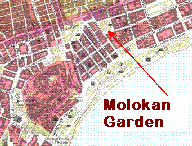 Downtown Baku. Aerial photo below shows the same area. This photo is very large (212K) 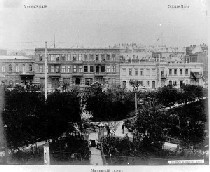 Old tourist postcard labeled "Mariinsky Square" 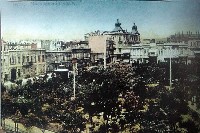 Old tourist postcard labeled "Molokanskii Garden" 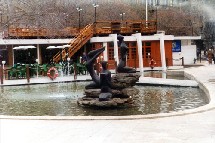 This was the first photo I found whch is now on the Baku Photo Gallery website, "Modern Baku": page 02, photo T012. Click on photos to ENLARGE. 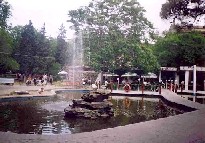 |
|||||||||||
|
|
||||||||||||
Spiritual Christians Around the World
